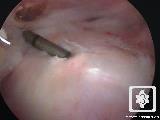Calcific Tendonitis
Calcific tendonitis refers to a build-up of calcium in the rotator cuff (calcific deposit). When calcium builds up in the tendon, it can cause a build up of pressure in the tendon, as well causing a chemical irritation. This leads to pain. The pain can be extremely intense. It is one of the worst pains in the shoulder (the other being Frozen Shoulder ).
In addition to the chemical irritation and presssure, the calcific (calcium) deposit reduces the space between the rotator cuff and the acromion, as well as affecting the normal function of the rotator cuff. This can lead to subacromial impingement between the acromion and the calcium deposit in the rotator cuff when lifting the arm overhead.
The cause of the calcium build-up in the rotator cuff is not known. It tends to be more common in people between the ages of 30-60 years of age. It does eventually disappear spontaneously, but this can take between 5 to 10 years to resolve.
Calcific deposit in the rotator cuff of the shoulder:
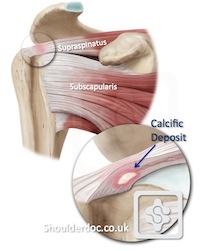
Diagnosis
The calcific deposit can be seen on plain x-rays, however ultrasound scan is better to find small calcific deposits which can be missed on x-rays. Ultrasound also makes it possible to assess the size of the deposit in all directions. The clinician can also see the blood vessels around the calcific deposit.
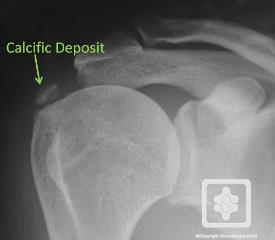
Calcific deposit on x-ray
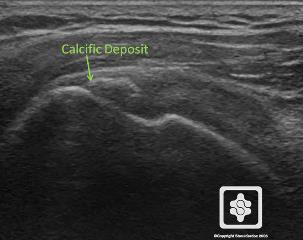
Calcific deposit on ultrasound scan
Click Here for a video of a calcific deposit on Ultrasound Scan
Animation showing the correlation of the ultrasound and x-ray views:
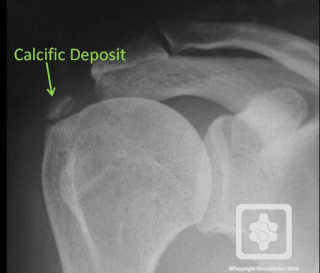
Treatment
Treatment of calcific tendinitis involves:
1. Painkillers and anti-inflammatory medications
2. Physiotherapy - keeps your shoulder strong and flexible and reduce the irritation
3. Cortisone steroid injections - reduces inflammation and control the pain
4. Ultrasound guided Barbotage - under ultrasound guidance the calcific deposit is injected with a salt water solution and the calcium is also sucked out into a syringe. The area is then repeatedly washed.
5. Surgical excision
Surgery for Calcific Tendonitis:
Surgery is required if the pain is not controlled with the methods above and/or the pain is extremely severe, with night pain.
The goal of any surgery to reduce the effects of impingement, by increasing the amount of space between the acromion and the rotator cuff tendons, which will then allow for easier movement and less pain and inflammation. The calcium deposit is also debrided and released at the same time. The operation performed is Arthroscopic Subacromial Decompression & Excision of the Calcific Deposit .
Patient Experience: |


